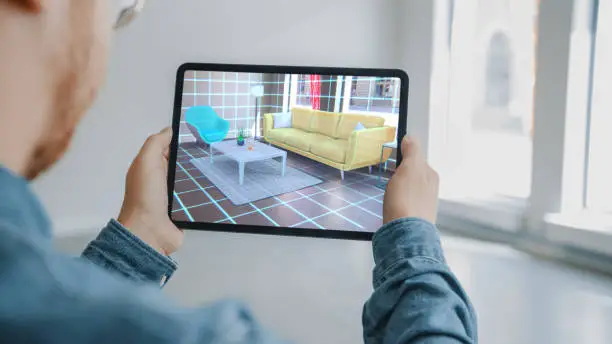Introduction
Augmented Reality (AR) has emerged as a groundbreaking technology that seamlessly integrates the digital and physical worlds, offering users an enhanced and immersive experience. As technology advances, AR plays a pivotal role in various industries, from gaming and education to healthcare and retail. This blog post explores the evolution of augmented reality, its current applications, and the potential it holds for the future.
The Evolution of Augmented Reality
Origins of Augmented Reality
Augmented Reality traces its roots back to the 1960s when computer scientist Ivan Sutherland introduced the first head-mounted display system called the “Sword of Damocles.” Although rudimentary by today’s standards, this invention laid the foundation for the development of AR technology.
Milestones in AR Development
Over the decades, augmented reality has undergone significant advancements. In the 1990s, Boeing researcher Tom Caudell coined the term “augmented reality” to describe a digital display used by aircraft electricians. The early 2000s saw the advent of AR applications in sports broadcasting, providing viewers with real-time data and statistics during live events.
The release of smartphones in the late 2000s marked a turning point for AR, making it accessible to a broader audience. Mobile AR apps, such as Layar and Wikitude, allow users to overlay digital information onto their physical surroundings using their device’s camera.
The Rise of AR Platforms
The launch of AR platforms, including Apple’s ARKit and Google’s ARCore, has democratized AR development. These platforms provide developers with tools and frameworks to create AR applications for iOS and Android devices, fostering a thriving ecosystem of AR experiences.
Current Applications of Augmented Reality
Gaming and Entertainment
Augmented reality has significantly impacted the gaming industry, offering a new dimension of interactivity. Games like Pokémon GO became global phenomena by blending virtual characters with the real world, encouraging players to explore their surroundings. Beyond gaming, AR is enhancing entertainment experiences through immersive storytelling and interactive exhibits.
Education and Training
AR is revolutionizing education by providing interactive and engaging learning experiences. Applications like Google Expeditions enable students to take virtual field trips, while anatomy apps allow medical students to explore 3D representations of the human body. In corporate training, AR is used to simulate real-world scenarios, improving employee skills and retention.
Healthcare and Medicine
Augmented reality is making significant strides in healthcare, from surgery planning to patient care. Surgeons can use AR to visualize patient data during procedures, enhancing precision and reducing risks. AR is also employed in medical education, allowing students to practice surgeries in a simulated environment. A great example of this is Hippo Virtual Care.
Retail and Shopping
AR is transforming the retail landscape by offering customers immersive shopping experiences. Virtual try-on apps enable users to visualize products, such as clothing and cosmetics, before making a purchase. AR-enhanced shopping environments, like IKEA’s Place app, allow customers to preview furniture in their homes using their smartphones.
Navigation and Wayfinding
Augmented reality is enhancing navigation applications by providing real-time information about the user’s surroundings. AR navigation overlays digital directions onto the physical world, making it easier for users to find their way in unfamiliar places. This technology is particularly valuable for pedestrians and cyclists.
Social Media and Communication
Social media platforms are integrating AR features to create more engaging content. Snapchat and Instagram filters use AR technology to add virtual elements to photos and videos, while video conferencing apps incorporate AR effects to enhance communication. These features have become increasingly popular for personal and business use.
The Future of Augmented Reality
Advancements in AR Hardware
As AR continues to evolve, the development of more advanced hardware is crucial. Companies are working on lightweight and stylish AR glasses like Digilens ARGO, that can provide a seamless and immersive experience. The integration of technologies like spatial computing and gesture control will further enhance user interactions with AR content.
5G Connectivity and Edge Computing
The widespread adoption of 5G connectivity will play a pivotal role in the future of augmented reality. Low-latency and high-bandwidth networks will enable real-time AR experiences, making applications more responsive and immersive. Edge computing, which processes data closer to the source, will reduce latency, enhancing the performance of AR applications.
Expanded Applications in Industry
Augmented reality will continue to find applications in various industries, including manufacturing, maintenance, and construction. AR-enabled smart glasses can provide workers with real-time information and instructions, improving efficiency and safety. These applications have the potential to revolutionize how tasks are performed in industrial settings.
AR in Art and Design
Artists and designers are exploring the creative possibilities of augmented reality. AR art installations and exhibitions allow viewers to interact with digital elements in physical spaces. Designers can use AR to prototype and visualize their creations in real-world environments, providing a more immersive and realistic preview of their work.
Integration with the Internet of Things (IoT)
Augmented reality will become increasingly intertwined with the Internet of Things (IoT), creating a seamless connection between the digital and physical worlds. AR devices can interact with IoT-enabled objects, providing users with contextual information and control over their surroundings. This integration will have implications for smart homes, smart cities, and industrial IoT applications. Learn more about Moziware CIMO.
Conclusion
Augmented reality has come a long way from its humble beginnings, evolving into a transformative technology with diverse applications across industries. As hardware improves, connectivity advances and new use cases emerge, the future of augmented reality looks promising. From enhancing how we play games and learning to revolutionize how we work and shop, AR is reshaping the way we experience and interact with the world around us. As we embark on this exciting journey of technological innovation, the possibilities for augmented reality are limited only by our imagination.







